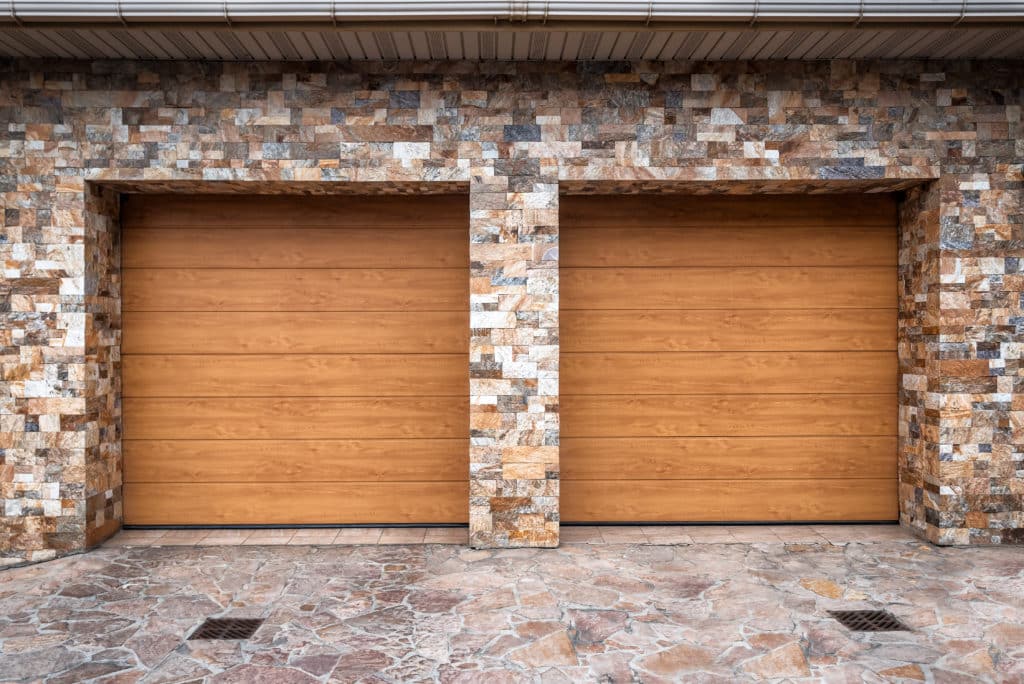Wooden garage doors have been gaining popularity in recent years, and for good reason. Simultaneously sophisticated and rustic, these modern garage doors are extremely versatile. With many colors to choose from, finding the perfect wooden door for your home’s aesthetic is a piece of cake.
The most crucial decision to make when planning to add a modern wood garage door to your home’s facade is whether to opt for a real wood door or a faux wood door. While both have plenty of customization options to optimize your door’s beauty and utility, there are some key differences to consider when selecting your door’s material.
Real Wood Garage Doors: Pros and Cons
Thinking of installing a real wooden door to your garage? As with any decision, this has its benefits as well as its drawbacks.

Benefits of Real Wood Garage Doors
- Natural Beauty: Real wood has a classic, timeless look that is difficult to truly replicate with any other material. Many faux wood manufacturers will repeat wood grains, which you’ll never have to worry about with a door made of real wood.
- Durability: With proper maintenance, real wood garage doors can last for decades. They are resistant to dents and scratches, making them ideal for high-traffic areas. Plus, the natural oils in wood provide a natural barrier against moisture, ensuring your door stays in excellent condition for years to come.
- High Resale Value: According to the 2018 Remodeling Cost vs Value Report, a high-quality door for your garage will typically net a 98% return on investment upon selling your home.
Drawbacks of Real Wood Garage Doors
- High Maintenance: Real wood garage doors require regular maintenance to keep them looking their best. Forgoing this maintenance can lead to rot, warping, fading, or cracking. At the very least, you’ll need to re-seal the door regularly, and re-stain it every couple of years.
- Cost: Real wood garage doors cost more than other materials for a variety of reasons. The added weight needs more high-end equipment and maintenance costs can add up over time, making a real wooden garage door a significant investment.
Faux Wood Garage Doors: Pros and Cons
Depending on your home improvement goals, a faux wood garage door might be just what you need.
Benefits of Faux Wood Garage Doors
- Low Maintenance: Fake wood garage doors are designed to mimic the look and feel of real wood, but they require less maintenance. They are made from durable materials such as fiberglass or steel, which are more resistant to warping, cracking, and rotting.
- Cost-effective: Faux wood is a more affordable option than real wood. Give your garage door the same “wood look” without the high price tag.
- Energy Efficient: Faux wood garage doors are typically better insulated than real wood doors. By keeping your garage warm in the winter and cool in the summer, you can cut down on energy bills in the long run.
Drawbacks of Faux Wood Garage Doors
- Limited Customization Options: Unlike real wood, faux wood garage doors are available in a limited range of colors and finishes, which may not match the style of your home as well as real wood doors.
- Less Authentic: While the fake wood doors may fool passersby, the difference is noticeable up close. If you’re looking for a truly authentic look, real wood doors are the better option.
Making this decision will be entirely up to your personal preferences, budget, and the style of your home. For help with every step of the process — from designing your dream door, to installation, to routine maintenance — talk to your friendly neighborhood PNG Garage Doors technician.
Ready to upgrade your garage’s look and utility? Call PNG today for a free consultation!
